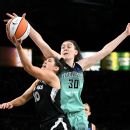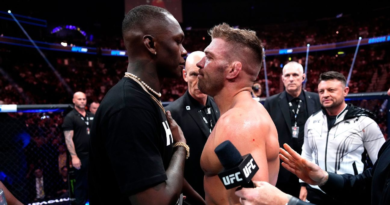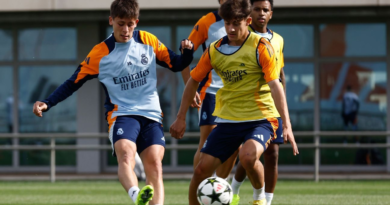From shortstop to right field, pickleball to the playoffs, there's nothing Mookie Betts can't do
The pickleball craze that swept the United States in recent years finally reached Mookie Betts some time around January. It became his go-to extracurricular activity in spring training, during which he arranged for a custom court to be built on the lawn of his home in the Los Angeles suburb of Encino. The project was finished by late June, about a week after he fractured his left hand on a hit by pitch. It was perfect timing. Betts was quickly able to replace one obsession — learning shortstop, arguably his sport’s most difficult position, on the fly — with another: pelting plastic balls with 16-inch paddles.
“I’m the type of person who can’t just sit down,” Betts said. “I don’t operate that way.”
Betts’ season has been about as dynamic as his disposition. It began with him preparing to become a full-time second baseman, after eight seasons and six Gold Gloves in right field, only to switch to shortstop less than a week before he and the rest of the Los Angeles Dodgers flew to South Korea to open their season. Betts spent the next three months painstakingly trying to pull off the type of midcareer position change no player of his stature had ever attempted, then spent the next eight weeks rehabilitating an ill-fated injury — only to return to right field and settle into the No. 2 spot of the lineup.
When Betts went down June 16, he led the National League in FanGraphs wins above replacement. Since coming back Aug. 12, he ranks fourth in win probability added. He’s producing at his customary level, with a .293/.377/.500 slash line, 19 home runs and 16 stolen bases in 111 games. But his value to this year’s Dodgers has been marked by acquiescence and proficiency. He moved out of leadoff, a spot where he’d made 80% of his career starts, and helped pave the way for Shohei Ohtani‘s unprecedented 50/50 season. And he moved all over the field to accommodate the Dodgers’ roster construction.
“I don’t think you can quantify the value of his willingness to move around the diamond,” Dodgers manager Dave Roberts said. “You just don’t see superstars willing to put themselves out there to potentially fail. And there’s no place on the diamond that you probably can get exposed more than at shortstop.”
There’s a part of Betts that misses shortstop. Misses sweating through those early afternoon hours while repeatedly taking ground balls from every conceivable angle. Misses sitting on the grass with coaches and analyzing his footwork on a tablet that recorded his every move. Misses peppering veteran shortstop Miguel Rojas with questions about how to handle the multitude of situations that come up in a game. Misses immersing himself in something new and exciting and difficult.
“I had the time of my life,” Betts, 31, said.
He also learned something about himself.
“I’m a lot stronger than I thought. I can do more things than I thought.”
Betts had spent much of his time in L.A. longing to return to second base, where he spent most of his time in the minor leagues. He finally got his wish heading into the 2024 season, with Jason Heyward looking like a sensible option for semi-regular playing time in right field. But then Gavin Lux‘s throwing issues re-emerged in the wake of knee surgery, and suddenly, a handful of days into March, the Dodgers were left scrambling.
The only way they could preserve their most talented lineup was for Betts to somehow learn shortstop — for a future Hall of Famer to open himself up to criticism and make himself vulnerable at the height of his powers.
Betts saw it as an opportunity to face a fear.
“On the other side of that fear and all the criticism is bliss, beautifulness,” Betts said. “That’s where my brain was — ‘Get through all this. Once you get through it, it’s going to be great.'”
Betts is often self-deprecating and at times even self-loathing, a trait that has helped him unlock athletic greatness at 5-foot-9 and 180 pounds. His foray into shortstop, a task that satiated his constant need for challenges, brought out the most extreme versions of his meticulousness. But the difficulty of it, and the scrutiny that surrounded it, helped him find balance.
“I wasn’t going to be self-critical while everybody else was, too,” Betts said. “It wasn’t going to be me and everybody else against me, that’s for damn sure. It was going to be me against the world at that point. That’s the thing I really learned — how to be my own cheerleader. How to be my own best friend.”
Betts committed nine errors in 61 starts at shortstop, all but one of which were the result of throws. Some of the advanced metrics did not grade him out favorably. But he was adequate. And he was steadily improving. And if he continued to hone in on the footwork required to make throws from certain angles, Dodgers infield coach Dino Ebel believes, he could have vied for a Gold Glove there eventually.
“Unfortunately we didn’t get to that part, but I think we were on our way, man,” Betts said. “I’m just proud of myself for accepting the challenge that comes with it.”
If not for the 98-mph fastball that ran in on his hands in the middle of June, Betts could have remained at shortstop and perhaps even given Ohtani a run for the MVP. But Betts didn’t spend much time lamenting the injury. He appreciated the rare time it provided with his family; how it helped him get closer to his 17-month-old son, Kaj. And he cherished all the pickleball he got to play with his wife, Brianna, a quasi-tradition they’ve maintained after home games throughout the season.
By the time Betts was healthy enough to return, Ohtani was thriving in the leadoff spot and Roberts began to see the benefit of using the right-handed-hitting Betts to split up the lefty-hitting Ohtani and Freddie Freeman at the top of his lineup. At that point, Rojas, the best defensive shortstop on the team, was in the midst of a career year offensively, Lux had completely turned his season around while solidifying himself at second base and Heyward’s bat had slowed.
“The thing that keeps Mookie going are certain challenges,” Roberts said, “but I do think he is smart enough to understand the roster, the landscape of our ballclub and what makes sense for our ballclub. And at that point in time, it was clear that he needed to go to right field.”
Given the uncertainty of their starting rotation — Tyler Glasnow and Gavin Stone are out; Clayton Kershaw is still on the mend; Jack Flaherty, Yoshinobu Yamamoto and Walker Buehler have each had their struggles — the Dodgers will probably have to win with offense in October. And Betts will have to be a catalyst. Encouraging signs have emerged lately.
Twice, an opponent has chosen to intentionally walk Ohtani to instead pitch to Betts. Twice, Betts has made them pay — with a three-run homer in the 10th inning from Angel Stadium on Sept. 3 and a ninth-inning, go-ahead single from Atlanta on Sept. 15. Seven days later, in a come-from-behind win against the Colorado Rockies, Betts hit his first walk-off home run as a Dodger immediately after Ohtani tied the score in the ninth.
Betts has thrived in high-leverage moments throughout his career, though he has accumulated just two hits in 25 at-bats over the past two division series — both of which ended in stunning elimination. This year, he believes, there’s a certain ease with which he navigates stressful situations. He trusts his preparation and lives with the results of it, sparing himself the second-guessing. It’s a shift.
“This is all definitely learned,” Betts said. “I used to be way more hard on myself. ‘I got to get ready for hitting second.’ ‘I got to get ready to play shortstop.’ ‘I got to do this.’ ‘I got to do that.'”
Perhaps it was a fear of failure. Perhaps, as Betts said, “It was not looking far enough through that fear to get to the other side.
“Now I’m a little older. Now I understand that whatever fears there are, man, I’m facing them dead-on.”



